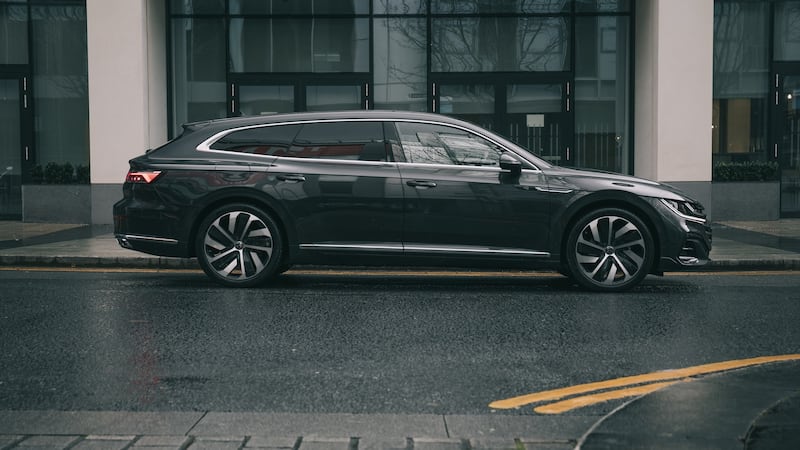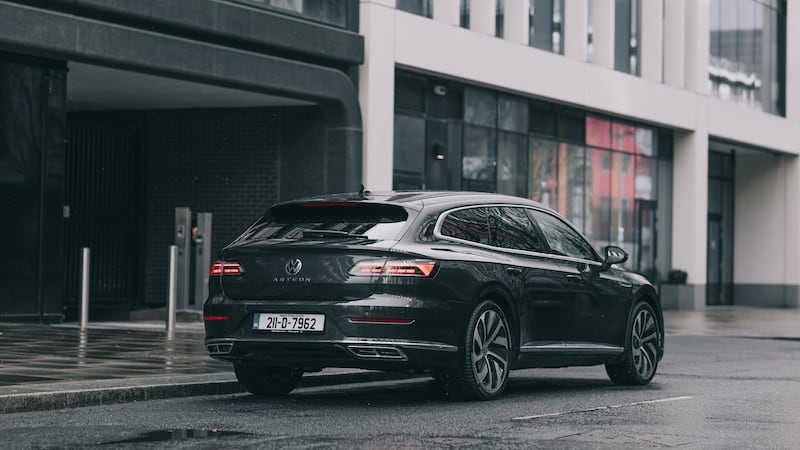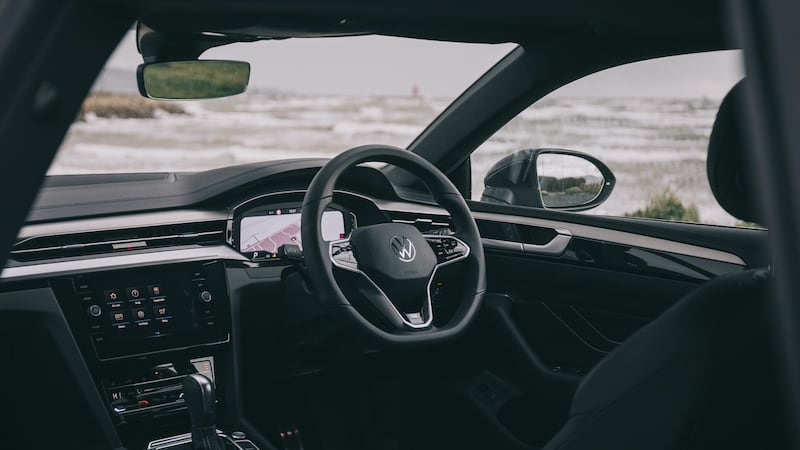Hello up there, all of you sitting high in the atmosphere in your SUVs and crossovers. Lower oxygen concentration slowing you down yet? Well, be patient, it will. While the rest of the world succumbs to the apparent collective psychosis of thinking that SUVs are – automatically – practical and sensible family cars, I’ll be riding lower than a snake’s dangly bits here in the Volkswagen Arteon Shooting Brake.
Well, sort of. Let’s clear up a couple of things first. The Arteon is actually not all that low-slung in real terms. After all, it shares much of its mechanical makeup with the VW Passat and the Skoda Superb, so there’s a limit to how actually really low down you are. It’s just that, dropping your bum down in past the frameless door glass (love us some frameless door glass), it feels so much lower in comparison to all those wannabe 4x4s that perch you an apparent 6ft in the air (even if the actual difference in seat height is measured in centimetres, really).
Once ensconced, you look at the world a little differently. When you’re not riding high and mighty above things, I reckon – no joke – that you actually feel a little more connected to the world around you, and that surely has to be a good thing. Plus, I’ve always, always felt safer and more secure in cars that place their centre of gravity as close to the tarmac as possible, and that the Arteon does with some style.
Second thing to clear up – it’s not a Shooting Brake. Shooting Brakes, just to get nerdishly technical for a moment, have two front doors and a rear hatch. Anything with four front doors that calls itself a Shooting Brake or Shooting Break (sic errat transcriptum and that’s your actual Latin dontcherknow) would be more honestly badged as Practical Estate But We Want You To Think That It’s Posher Than It Is.
The Shooting Brake (no it isn’t. . .) is the latest addition to the Arteon range, and comes as VW’s big four-door coupe gets a general mid-life update, with some new engine options, uprated electronic safety equipment and an interior that benefits from some new equipment such as digital instruments.

You can get VW’s new 200hp TDI four-cylinder turbo diesel engine in the Arteon, but our test car came with the lower-power 150hp, 360Nm version. Like the more powerful model, it gets the “twin-dosing” AdBlue system that aims to put a firm cap on the engine’s emissions of harmful NOX gases, but if you really wanted to assuage your guilt, there is a GTE-badged plug-in-hybrid model, priced from €51,365 if you have a driveway for charging and mostly do short urban hops.
Yes, that’s more than €50,000 for a big estate with a VW badge, and that might be too much of a price pill for many to swallow. For those that are struggling, better look away now before I mention that our test car clocked in with a tag of €55,852, including options. Gulp. There’s little doubting that a Passat estate, or a Skoda Superb Combi, with identical underpinnings, would make for far better value.
Not better style, though. Aside from the frameless doors, there is that low, ground-hugging nose, and relatively sleek overall styling which blends well with the estate (not a shooting brake. . .) body. Yes, in the black paint of our test car, there a faintly funereal touch, but it’s worth the undertaker overtones for the practicality. In spite of the Arteon’s sleekness, there’s a 590-litre boot for you to fill with your needful items, which expands to 1,632 litres with the rear seats folded. There’s also a huge 2.83m wheelbase – fractionally longer even than that of the big Skoda Superb – which means that there’s proper lounging space in the back.

Up front, aside from the new digital instruments, there’s the same touch-sensitive air conditioning controls as you’ll find in the new Tiguan SUV, and some detail changes to trim and fittings. It’s a very comfortable cabin, one in which is incredibly easy to while away an endless journey – which is just as well, as that frugal diesel engine will put more than 1,100km between top-ups of the big 66-litre fuel tank. Check out that 135g/km CO2 figure, too – any equivalently practical SUV would be far more emissions-heavy.
Of course, there is a prickle of conscience to driving any big diesel-engined car these days, but the good news is that once the new ID.6 large electric SUV has been launched, VW has said that it’s next all-electric models will be a more low-slung saloon and estate, very much in the mould of the Arteon.


Does being this low down really benefit you? In handling terms, probably not much – switch the drive mode selector into Sport and the Arteon corners briskly and with stability, but not much involvement. It's still a massive step ahead of any SUV you might care to mention (aside, perhaps, from those wearing Porsche badges) and the lack of height and frontal area means you'll get close to 60mpg fuel economy even on a long cross-country run. If there's a flaw, it's in the springs. All MQB-based cars (MQB being the hugely flexible chassis, engine, and component set used by almost all non-electric VW cars) suffer to an extent from noisy suspension and too much tyre noise, but while that's vaguely acceptable on a €25,000 Golf or Skoda, it's not so great in a big Arteon costing the thick end of €60,000.
So while the Arteon’s sporting credentials are pretty much only skin deep, it’s unquestionably a car with huge appeal and no little charisma. Expensive for something with a VW badge and a mere 150hp? Without question, but there are people out there spending that on taller cars which supposedly offer more, but actually deliver rather less. Lower is better, people. Lower is better.
Volkswagen Arteon Shooting Brake: The lowdown
- Power 2.0-litre turbo diesel engine putting out 150hp and 360Nm of torque with a seven-speed automatic transmission and front-wheel drive.
- CO2 emissions (annual motor tax) 135g/km (€200)
- L/100km (MPG) 5.3 (53.0)
- 0-100km/h: 9.4 seconds
- Price: €55,852 as tested; Arteon starts at €46,100
- Verdict: Low down is better than high up, and the Arteon is as practical as it is handsome.










